Tropentag 2013
Trees, diets and urban planners?
Wed, 09/25/2013 - 15:42 — Paulina Campos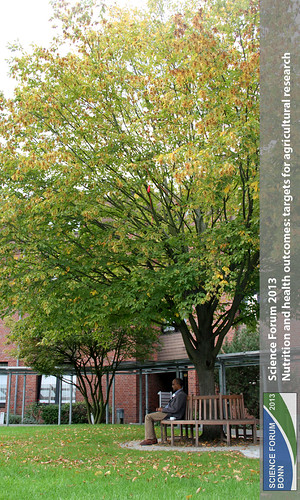 We might often think of trees from an ecological point of view, delivering ecosystem services such as carbon sequestration or preventing soil erosion. But what about their dietary value? How can they contribute to improve food security and nutrition? Do children in areas with more trees have more diverse diets? Amy Ickowitz from the Center for International Forestry Research (CIFR) addressed these questions during her presentation “Role for forests for nutrition” during the session “Diet diversification”.
We might often think of trees from an ecological point of view, delivering ecosystem services such as carbon sequestration or preventing soil erosion. But what about their dietary value? How can they contribute to improve food security and nutrition? Do children in areas with more trees have more diverse diets? Amy Ickowitz from the Center for International Forestry Research (CIFR) addressed these questions during her presentation “Role for forests for nutrition” during the session “Diet diversification”.
How much biodiversity is on your plate?
Wed, 09/25/2013 - 13:23 — Paulina Campos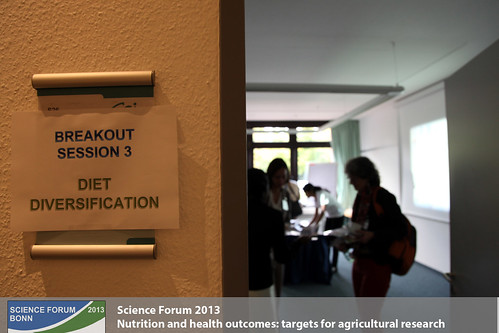 If the french writer and famous foodie Brillat-Savarin (1755-1826) would have been sitting among us at the breakout session about “Role of indigenous (forgotten) foods (plants and animals) in food diversification: what don’t we know?” he would be very dissapointed to see what we human kind has become. “Tell me what you eat and I’ll tell you who you are” wrote once Mr. Savarin. If we consider that from the 7.000 plant species and several thousand animal species used for human nutrition over the past 12.000 years, 98% of our modern diets relies only on 12 plant crops and 14 animal species, what would we answer if he asked us: who are you then now? A result of increasingly simplified diets which is the mirror of increasingly simplified agroecosystems.
If the french writer and famous foodie Brillat-Savarin (1755-1826) would have been sitting among us at the breakout session about “Role of indigenous (forgotten) foods (plants and animals) in food diversification: what don’t we know?” he would be very dissapointed to see what we human kind has become. “Tell me what you eat and I’ll tell you who you are” wrote once Mr. Savarin. If we consider that from the 7.000 plant species and several thousand animal species used for human nutrition over the past 12.000 years, 98% of our modern diets relies only on 12 plant crops and 14 animal species, what would we answer if he asked us: who are you then now? A result of increasingly simplified diets which is the mirror of increasingly simplified agroecosystems.
White flies just boarded a plane to Europe!!
Sun, 09/22/2013 - 23:05 — Pamella Ogada
“Strict” Border Restrictions are not enough to curb Pests and Diseases!!
Insane as it sounds, that is the reality of things.
Pests and Diseases management has been part of scientific discussions since time immemorial with regard to agricultural production systems. With this year’s conference theme, “Agricultural development within the rural-urban continuum”, pest and diseases was not left behind, and this brought great discussion among scientist from all over the globe.
 Stephan Winter Leibniz-Institute, Braunschweig, Germany
Amazing interactions between plant viruses, their vectors and their hosts plants was reported by Stephan Winter, a virologist from Leibniz-Institute, Braunschweig, Germany. According to Winter, plant viruses can travel long distance as far as United State from Africa, to Europe. This has been made possible by international trade of planting materials, vegetables and cut flowers, enabling pests and diseases of economic importance to cross strict boarders.
Generally, several driving factors have been found to contribute to this menace, scientist are committed to find solutions for the control and containment of pests and diseases.These include, cultural measures, biological control of the pest, use of tolerant crop varieties against plant diseases among others.
Stephan Winter Leibniz-Institute, Braunschweig, Germany
Amazing interactions between plant viruses, their vectors and their hosts plants was reported by Stephan Winter, a virologist from Leibniz-Institute, Braunschweig, Germany. According to Winter, plant viruses can travel long distance as far as United State from Africa, to Europe. This has been made possible by international trade of planting materials, vegetables and cut flowers, enabling pests and diseases of economic importance to cross strict boarders.
Generally, several driving factors have been found to contribute to this menace, scientist are committed to find solutions for the control and containment of pests and diseases.These include, cultural measures, biological control of the pest, use of tolerant crop varieties against plant diseases among others.
 Stephan Winter Leibniz-Institute, Braunschweig, Germany
Amazing interactions between plant viruses, their vectors and their hosts plants was reported by Stephan Winter, a virologist from Leibniz-Institute, Braunschweig, Germany. According to Winter, plant viruses can travel long distance as far as United State from Africa, to Europe. This has been made possible by international trade of planting materials, vegetables and cut flowers, enabling pests and diseases of economic importance to cross strict boarders.
Generally, several driving factors have been found to contribute to this menace, scientist are committed to find solutions for the control and containment of pests and diseases.These include, cultural measures, biological control of the pest, use of tolerant crop varieties against plant diseases among others.
Stephan Winter Leibniz-Institute, Braunschweig, Germany
Amazing interactions between plant viruses, their vectors and their hosts plants was reported by Stephan Winter, a virologist from Leibniz-Institute, Braunschweig, Germany. According to Winter, plant viruses can travel long distance as far as United State from Africa, to Europe. This has been made possible by international trade of planting materials, vegetables and cut flowers, enabling pests and diseases of economic importance to cross strict boarders.
Generally, several driving factors have been found to contribute to this menace, scientist are committed to find solutions for the control and containment of pests and diseases.These include, cultural measures, biological control of the pest, use of tolerant crop varieties against plant diseases among others.
No stress! How overwhelming conservational concerns can harm socio-economic factor.
Sat, 09/21/2013 - 15:42 — Vitalii Korol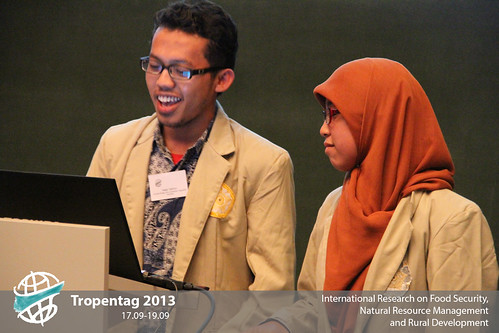 In the oral presentation session Resources within the Rural-Urban Continuum number of researchers prove that overwhelming concern about natural area and biodiversity protection can cause economic and social problems: agroforestry in Indonesia is more beneficial, than solely forest; use of wetlands for crop production in East Africa does not harm plant diversity; partial replacement of mangrove forest in Myanmar with rice farms is economically more viable, than forest alone; pastures in Caucasus Region are prioritized higher, than National Parks. see more
In the oral presentation session Resources within the Rural-Urban Continuum number of researchers prove that overwhelming concern about natural area and biodiversity protection can cause economic and social problems: agroforestry in Indonesia is more beneficial, than solely forest; use of wetlands for crop production in East Africa does not harm plant diversity; partial replacement of mangrove forest in Myanmar with rice farms is economically more viable, than forest alone; pastures in Caucasus Region are prioritized higher, than National Parks. see more
Could you live without coffee?
Sat, 09/21/2013 - 14:34 — Paulina Campos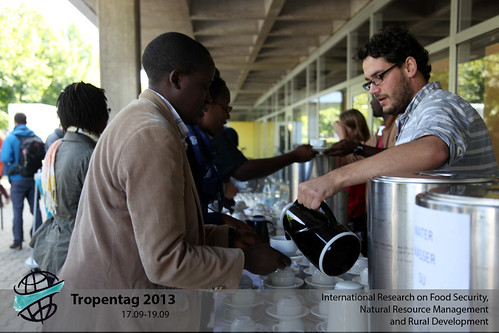 I personally would have a very hard time but still would be able to survive. But many smallholder coffee producers in San Juan del Río Coco in Northern Nicaragua would be left without their main and only source of income if they were not able to grow coffee anymore. Even if this scenario might turn into a reality in a year as far as 2050 the possibility is real and the chances quite big.
I personally would have a very hard time but still would be able to survive. But many smallholder coffee producers in San Juan del Río Coco in Northern Nicaragua would be left without their main and only source of income if they were not able to grow coffee anymore. Even if this scenario might turn into a reality in a year as far as 2050 the possibility is real and the chances quite big.
We should eat more vegetables...
Sat, 09/21/2013 - 12:22 — Viviane Meyer
... as pointed out in the AVRDC and IWMI session on the last day of Tropentag 2013. Malnutrition and diseases are a “hidden hunger” in this world and to combat this problem an obvious solution is given: Eat more vegetables!
 Andreas W. Ebert talking about tomatoes
Andreas W. Ebert talking about tomatoes
 Andreas W. Ebert talking about tomatoes
Andreas W. Ebert talking about tomatoes
Urban Agriculture - a hobby?
Fri, 09/20/2013 - 19:28 — Vitalii Korol
"Urban agriculture is only a complementary to the rural agriculture, however it is necessary for food and agriculture literacy" - states Dr. Joe Nasr.
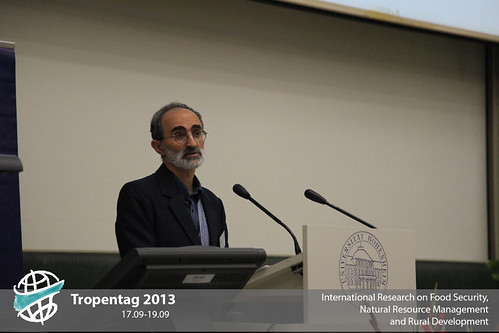 In his opinion, Urban Agriculture will remain only as an additional food supplier with its main function of supporting biodiversity of species, rather than be a main food source. He has worked on the topic of Urban Agriculture for over 2 decades and described major challenges and alternatives to the agro-industrial system in his leading presentation of the Oral Presentation Session "Development within the Rural-urban Continuum". more
In his opinion, Urban Agriculture will remain only as an additional food supplier with its main function of supporting biodiversity of species, rather than be a main food source. He has worked on the topic of Urban Agriculture for over 2 decades and described major challenges and alternatives to the agro-industrial system in his leading presentation of the Oral Presentation Session "Development within the Rural-urban Continuum". more
 In his opinion, Urban Agriculture will remain only as an additional food supplier with its main function of supporting biodiversity of species, rather than be a main food source. He has worked on the topic of Urban Agriculture for over 2 decades and described major challenges and alternatives to the agro-industrial system in his leading presentation of the Oral Presentation Session "Development within the Rural-urban Continuum". more
In his opinion, Urban Agriculture will remain only as an additional food supplier with its main function of supporting biodiversity of species, rather than be a main food source. He has worked on the topic of Urban Agriculture for over 2 decades and described major challenges and alternatives to the agro-industrial system in his leading presentation of the Oral Presentation Session "Development within the Rural-urban Continuum". more
European chicken populations are not prepared for future challenges
Thu, 09/19/2013 - 17:50 — Rahel Wyss
Livestock is a key livelihood component for poor households in developing countries but livestock diseases continually threaten the livestock assets, some of the local chicken populations are at risk of extinction, and in Europe there might be problems in the future with regard to conserving genetic diversity in chicken breeds.
 Christian Hülsebusch presenting a Boran Cattle Breeding Study done in Kenya
Christian Hülsebusch presenting a Boran Cattle Breeding Study done in Kenya
 Christian Hülsebusch presenting a Boran Cattle Breeding Study done in Kenya
Christian Hülsebusch presenting a Boran Cattle Breeding Study done in Kenya




